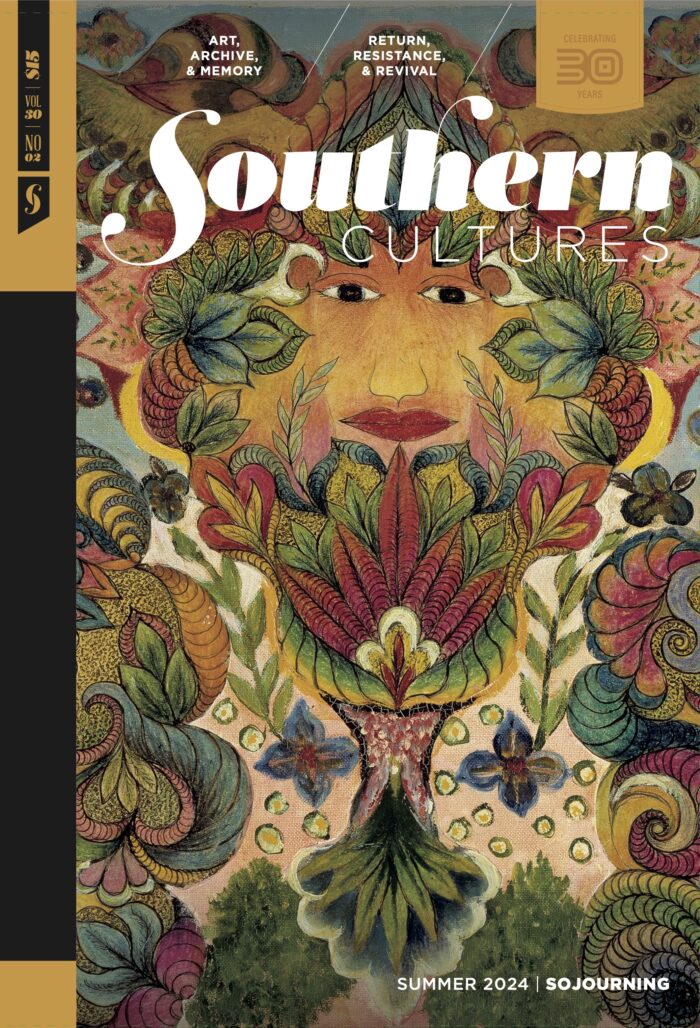Part of our Shutter series on southern photography, Grace Hale examines Sally Mann’s current exhibit at the National Gallery of Art, “A Thousand Crossings,” on view March 4–May 28, 2018.
Beauty is everywhere in photographer Sally Mann’s exhibition A Thousand Crossings at the National Gallery of Art. In the first room of the show, her son Emmett floats on his back in the river with his eyes closed and a towel draped low on his waist, looking in all but the absence of stigmata and his obvious youth like a sacrificed Christ. Nearby, Mann’s daughter Jessie stands like a nymph in naked profile high on a rocky river bank, as misty light from above makes the top of her head and her right hand glow. In another room, a triangle of pasture, some trees covered in kudzu, other straggling and clumped growth, and a strong vignette effect force the eye to the center of a photograph where fog rises from stacked and pleated Virginia hills. Farther on, an image of the battlefield at Antietam beckons with painterly abstraction as drifts of ghostly smoke suggest a faint sky above a dark and marred earth, and bare branches like skeletal hands reach into the top of the frame to gesture at the place where they lost their flesh. All this beauty, unfashionable, extravagant, and haunting, demands attention. What, I wondered, as I surveyed five large rooms filled with Mann’s photographs, does this art ask us to see?
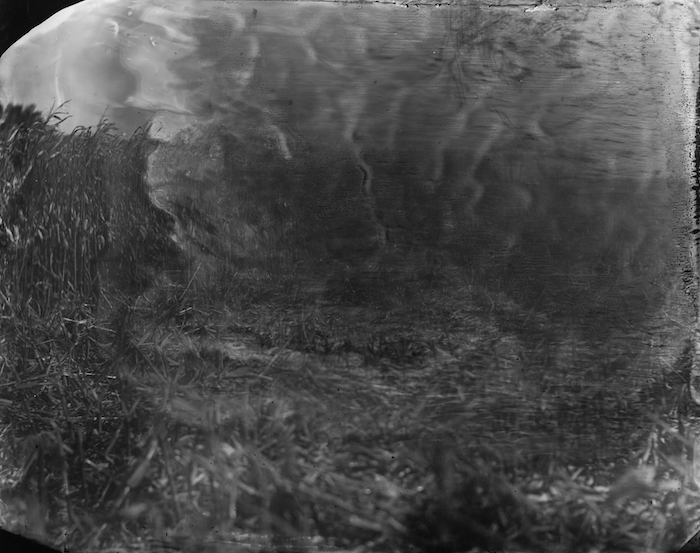
All this beauty, unfashionable, extravagant, and haunting, demands attention.
In her 2015 memoir Hold Still, Mann describes the qualities that make her work southern: “obsession with place, with family, with both the personal and the social past, the susceptibility to myth, the love of this light which is all our own, and the readiness to experiment with dosages of romanticism that would be fatal to most late 20th century artists” (24). Her regional identity is not simply an inheritance—her father, an atheist and an amateur artist as well as a doctor, grew up in Texas, but her mother came from New England. Instead, Mann suggests, she learned to be a white southerner from growing up in Lexington, Virginia, and from art. Mann, by her own account, had a “natural, unquenchable rebellious streak” and spent her youth rambling around the countryside with the family dogs and then on horseback. Sent off like her older brothers to a progressive boarding school in Vermont, she “missed Virginia, where sentimentality was not a character flaw . . . where memory and romanticism were the coin of the realm.” At the Putney School, an African American teacher named Jeff Campbell assigned the novels of Faulkner. Reading in bed in her dorm, Mann remembered, “my homesick romanticism thrummed to the melodrama: the violence, the undertones of sexual threat, the sense of moldering decadence, the cursed inheritance, and, of course, the inevitable haunted home place . . . a metaphor for the South.” Faulkner made her aware of her “ignorant childhood” and “the truth of all that I had not seen, had not known, and had not asked.” Regional history, Mann learned, was not something to commemorate, a truth not obvious in Lexington, where Washington and Lee, the college that employed Mann’s mother and later the photographer herself, displayed the bones of Lee’s horse Traveller like holy relics until 1971. It was a tragedy.
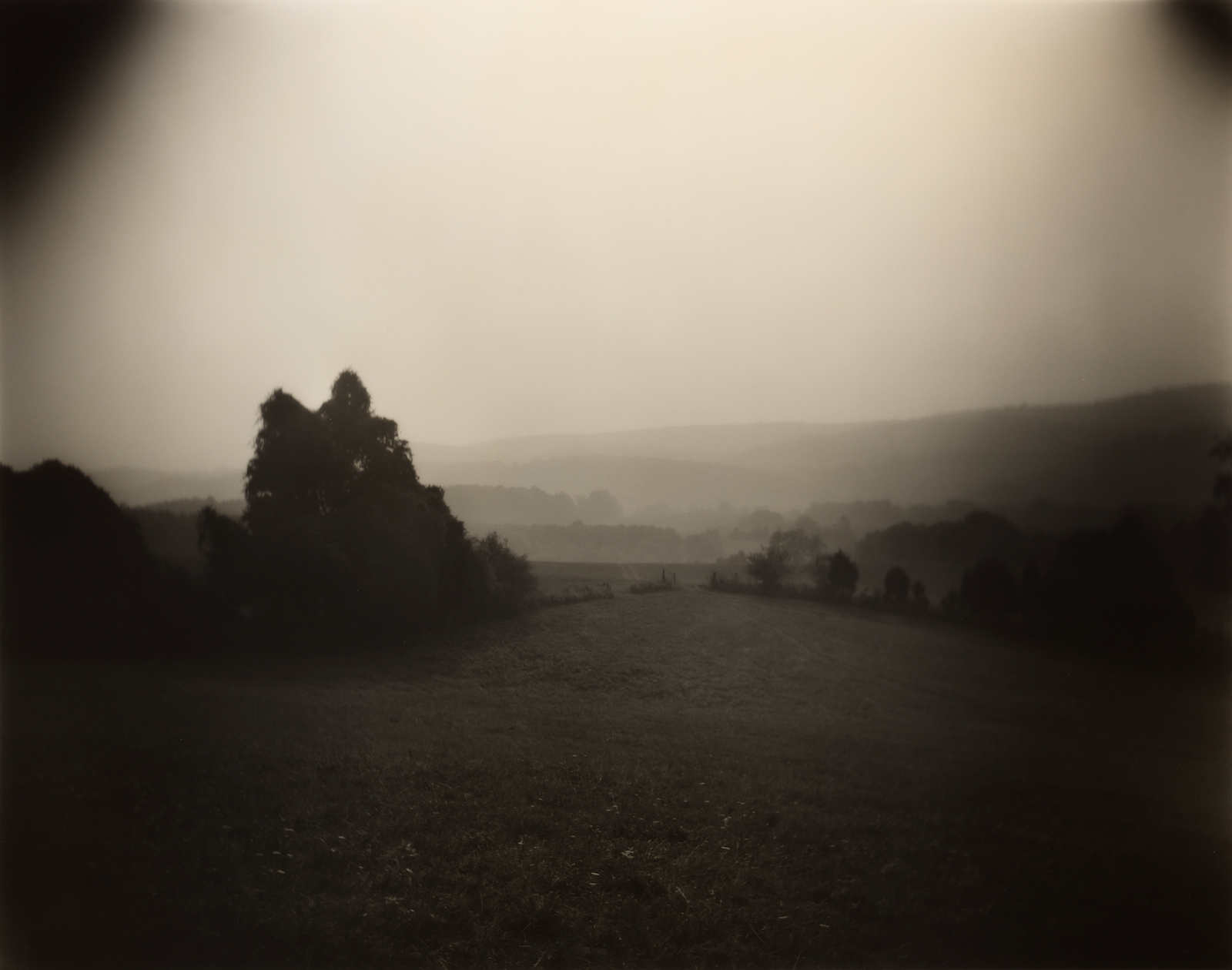
In 1999, reviewing the artist’s exhibition “Deep South” at New York’s Edwynn Houk Gallery, the critic Hilton Als wrote that Mann “wants to be a mythologizer, a Faulkner of the lens.” I kept thinking of this phrase as I lingered in the sections of this show called “The Land,” “Last Measure,” and “Abide with Me.” Like Faulkner, Mann deploys beauty and risks romanticism in order to grapple with how myth shapes memory in this region with too much past.
Like Faulkner, Mann deploys beauty and risks romanticism in order to grapple with how myth shapes memory in this region with too much past.
The National Gallery exhibition opens with a selection of the photographs Mann took of her children, her husband Larry Mann, and their friends in the 1980s and early 1990s at the family camp on a bend in the Maury River outside Lexington. In 1992, some of this work, published as Immediate Family, made the photographer both famous and infamous, revered by artists and denigrated by moralists for the way her images deconstructed easy ideas about both children and motherhood. The photographs from this body of work on display here seem chosen to avoid stirring up these old controversies, though Mann fans will find beautiful prints of classics like “Last Light,” “Jessie Bites,” and “The Last Time Emmett Modeled Nude,” as well as five rarely seen color photographs.
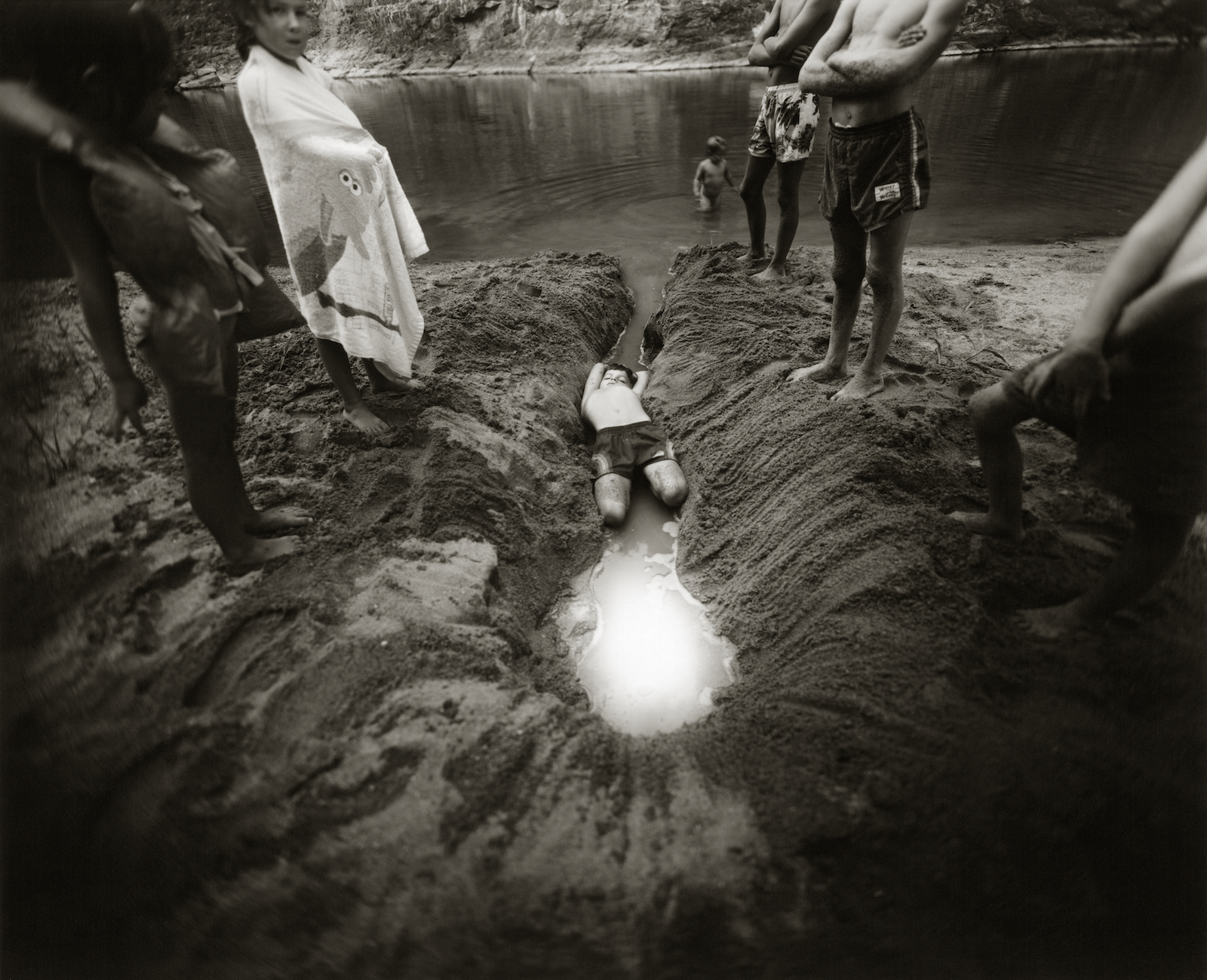
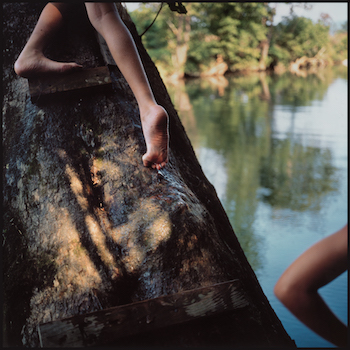
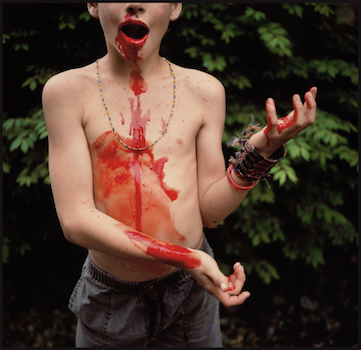
In these family pictures, Mann approaches mythmaking on an intimate and personal scale. As the artist confessed to a journalist in a 1992 interview, “I don’t remember the things that other people remember from their childhood . . . Sometimes I think the only memories I have are those that I’ve created around photographs of me as a child. Maybe I’m creating my own life.” As a mother, she makes this process more self-conscious and deliberate, collaborating with her children Emmett, Jessie, and Virginia in “spinning the story.” Using a shallow focus, sometimes placing a tube around the lens to produce a vignette effect, and directing her children’s gestures and expressions, Mann “fictionalizes” these family photographs and distances her art from documentary’s more direct relationship with the world. In the most powerful of these images, like “The Ditch,” on display here, the mythical and the documentary co-exist. Viewers can see the cycle of life and also Emmett and his friends playing at the river’s edge in the heat and sand of summer.
In the next two rooms of the show, “The Land” and “Last Measure,” Mann’s use of old photographic technologies make myth and history as much the subject of her work as the people and places on the other side of the lens. When Mann turned to landscapes in the mid-1990s, she moved away from regular film to experiment with different effects. Besides its slow speed and continuous tone, Ortho film had another advantage: greater control. Mann could look at her negatives while she developed them under a safe light. In the late nineties, she took up an even older process, coating glass plates with sticky collodion to hold light-sensitive chemicals in order to produce negatives that must be exposed and developed in the ten or so minutes before the material dries. Photographers like Alexander Gardner used this same wet plate process to make their now famous images of the Civil War. “Shooting with collodion,” Mann has said, enabled her to make photographs with “the appearance of having been torn form time itself.”
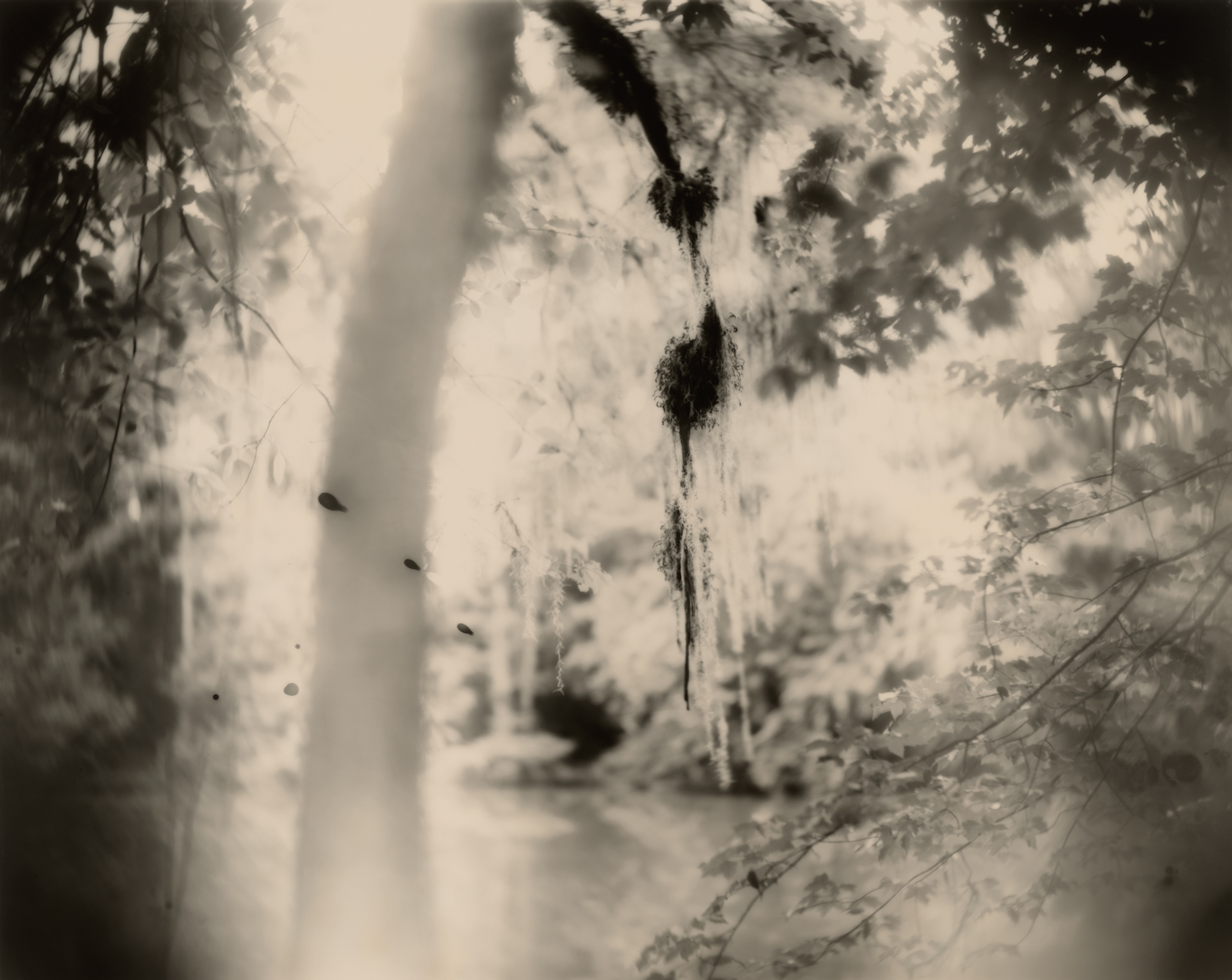
While newer papers and oversized prints make clear Mann’s work is not simply historical reenactment, the photographs the artist makes from this process look instantly old. When she begins to invite the kind of flaws and accidents that nineteenth-century photographers considered failures, she adds yet another layer of history, a look that suggests her negatives too have been ravaged by the past. These effects replicate the way the passage of time itself increases the distance between all photographs and their subjects. In these ways, Mann highlights the intermediate set of decisions and actions between the world and the camera, the hand of the artist.
The room titled “The Land” collects images of Virginia farmland and Deep South scenes. All of these landscapes, as the scholar Shawn Michelle Smith has suggested, resist “the view,” the sublime vistas made popular by American photographers working mostly in the West in the late nineteenth century. Instead, Mann’s photographs reveal hidden and closed-in spaces where fecund earth meets hot and humid air—secret places, hiding spots, private retreats, and unmarked historical sites.
Landscapes on which antebellum plantations have left their marks are an old subject in photography, shot by Walker Evans, Eudora Welty, Clarence John Laughlin, Carrie Mae Weems, and others. Mann’s doubling—old subjects and old processes—works as a metaphor for the history of history or the way change over time is not just something that happens to people and societies and photographs but also to accounts of the past. Romanticism is not so much the effect here but the subject.
In “Deep South, Untitled (Valentine Windsor),” ghostly, heart-shaped leaves bleached out by the haunting, heart-shaped light flutter between bare brick columns. The ruined negative—the crack that runs through the right column, the emulsion that peels around the edges, and the drops and puddles made by wayward chemicals—echo the broken houses and ruinous dreams of real life versions of Faulkner’s Thomas Sutpen.
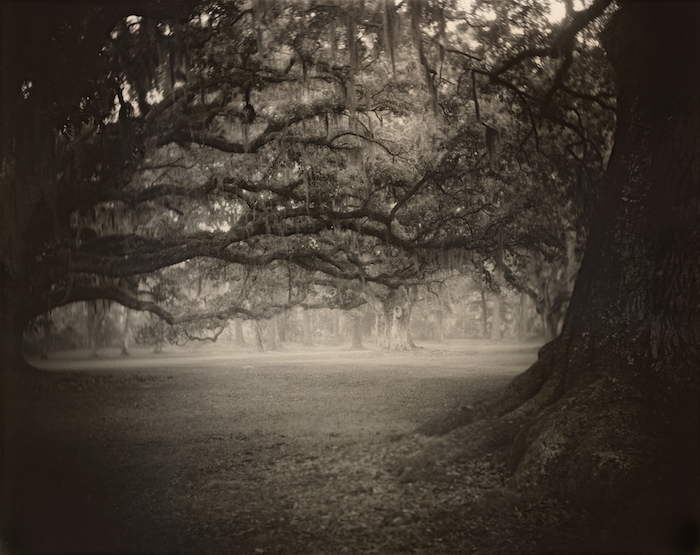
In not titling these images, Mann refuses any documentary function. What she is after here is myth. Still, without specifics like the parenthetical “(Emmett Till Riverbank)” attached to another image called “Deep South, Untitled,” we would have no way to know that this muddy and overexposed (in terms of the film, the erosion, and the past) rut leading into a murky river is a site where people believe the lynched boy’s body was found. And we have to know this detail as well as information provided by the wall text about “Deep South, Untitled (Bridge on Tallahatchie), a related image of the rusty bridge where Till’s body was probably heaved into the river. Romanticism alone is too risky. Telling us what these sites are in the world makes visible black Americans killed to achieve a white southern dream of mastery. Most African American viewers will not need to be reminded of this violence. Yet in giving landscapes of black loss an aesthetic treatment traditionally reserved for white nostalgia, Mann reaches for a kind of racial absolution. Her Till images make viewers think about whether art can play a role in deconstructing the very southern romanticism it helped create.
In a room called “Last Measure” (for me, the highlight of the show), Mann turns again to an important subject in the history of photography: Civil War battlefields. In the early 2000s, Mann visited sites like Antietam and Cold Harbor, landscapes in which thousands of Americans lost their lives.
Evoking the wartime images made by Gardner and others, she extends her experimentation with collodion almost into abstraction. Specks of dust and damage to the glass surface of her negatives create drips, puddles, and comets that evoke smoke, the heat and screams of battle, and flying bullets. Old equipment allows light flares and leaks. In some photographs, the perspective seems almost ground level, as if the earth itself is telling us what it felt like to be the site of so much horror and death. In “Battlefield, Manassas (Veins),” dark spots on a thin strip of glowing horizon suggest the rising spirits of the dead. There is beauty but not glory here, in Mann’s dark and elemental conjuring of scarred fields and groves and blood-soaked earth.
The perspective seems almost ground level, as if the earth itself is telling us what it felt like to be the site of so much horror and death.
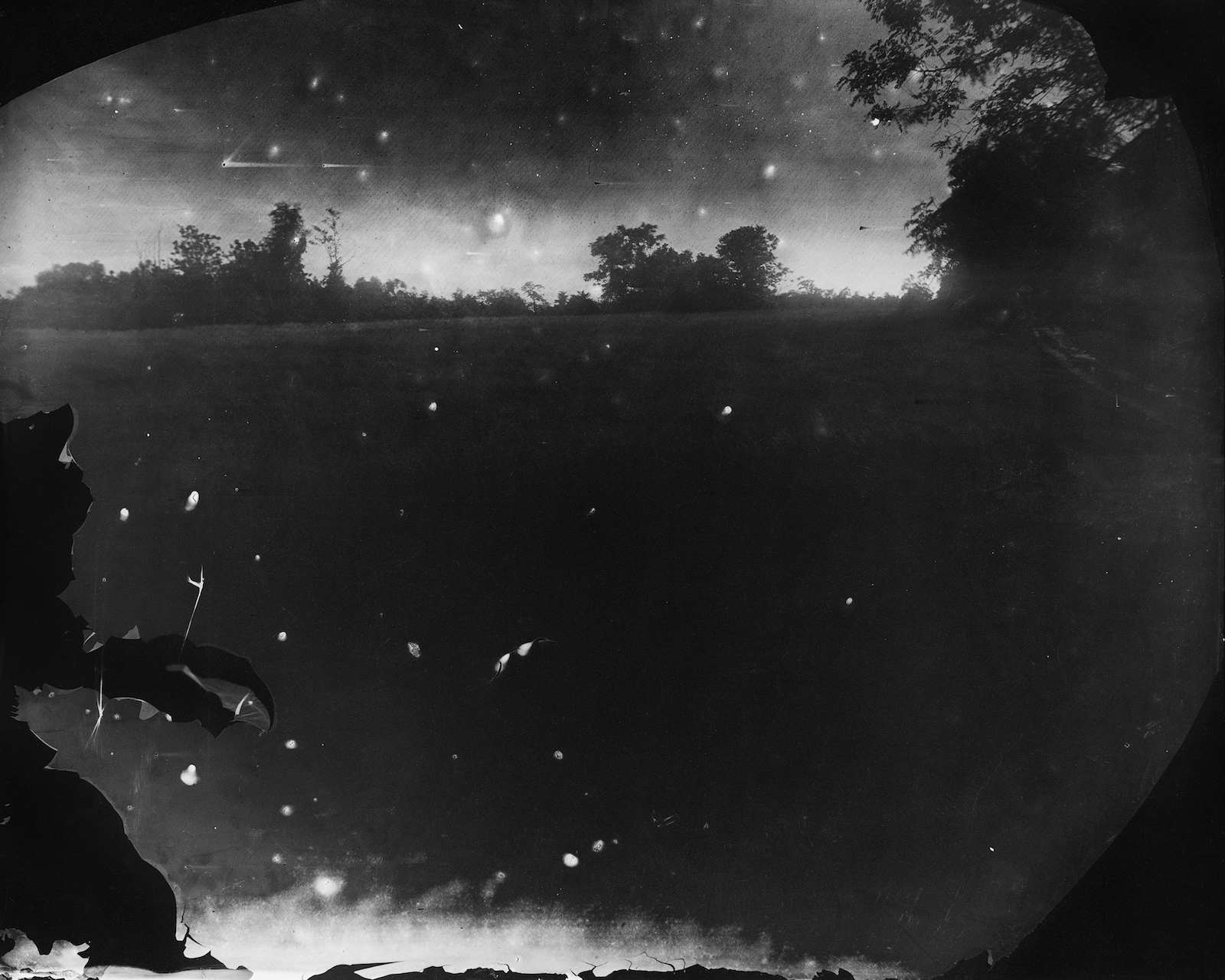
The last main room, “Abide with Me,” collects four different kinds of work that wall text positions as part of Mann’s attempt, since the early 2000s, “to consider how race, history, and the social structure of Virginia” shaped both her and the land she loves. The section begins with two large glass cases filled with snapshots and letters related to an African American woman named Virginia Carter who worked for the artist’s parents, a documentary project that feels out of place. Though Mann seems interested in the possibilities of integration, even the materials convey the different conditions of the families: the often large, crisp, and well-preserved photographs of Mann’s family, the Mungers, contrast with the often small, damaged, and out-of-focus Carter images. The documents and wall text reveal that Mann loved the woman she knew as Gee Gee, the namesake of the artist’s youngest child. They also suggest that Gee Gee cared deeply for Mann. Still, the connection the letters suggest Carter felt was complicated by chasms of race and class and a job that required this emotional response. Faulkner, too, used his art, his language, in the form of a funeral speech and the dedication of his novel Go Down, Moses, to honor “Mammy” Caroline Barr, the African American woman he claimed raised him. With these glass cases and four of her own prints of Carter and Virginia Mann, titled “the Two Virginias,” Mann honors the woman who raised her. Yet in the context of a photography exhibition with much to say about how myth shapes history, these pieces evoke the very myths that have historically perpetuated rather than countered white supremacy.
In addition to the work on Virginia Carter, the room includes three other bodies of work, images offer often-revisited subject in the history of photography, African American churches in the rural South, a series of tintypes of watery scenes called “Blackwater,” and five portraits of black men. Mann seems to be trying here to grapple with the black southern experience, with what places and pasts look like from the other side of the color line. Printed on old and expired paper to produce a different kind of historic look than collodion and arranged in grids, the church photographs recall and evoke earlier work by photographers like Walker Evans, William Christenberry, Eudora Welty, and Emmet Gowin, with one key difference. Many of them are buildings bereft of active congregations. Like the Till landscapes, they suggest a form of artistic restitution, a white artist making images of black history, of the traces left on southern land by the collective impact of black lives.
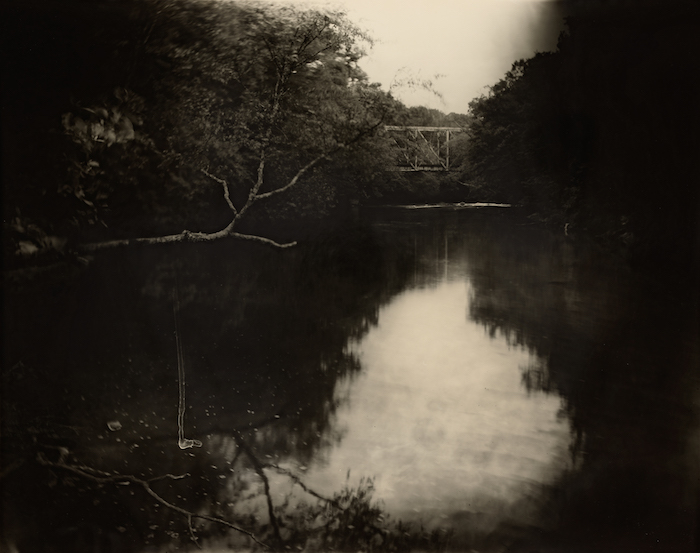
In this same room, the reflective surfaces of the brilliant “Blackwater” pictures turn swamps and riverbanks where trees meet water into mirrored silhouettes whose multiplying images include saplings, vines, and the very faces of viewers. The tintypes seem to float in that blurry space between myth and the world, as wall text reveals that Mann has made the images along the Blackwater and Nottoway Rivers, Nat Turner’s old territory, and in the Dismal Swamp, long a place of refuge for enslaved people hiding from their owners. What whites saw as wastelands of scrub and water and mud, blacks saw as sanctuary. In the past, black and white oppression and freedom stood as mirrored images—slavery and segregation meant that one side’s loss was the other side’s gain. This work pushes viewers to think about the degree to which we still live with and in these exclusive and opposing forms.
In the final series in this room, a set of five, mostly large prints, Mann turns the same technologies she used in her Civil War images on a subject otherwise absent in her art, black men. In these photographs, the often unclothed bodies of her models seem to slip between historical eras and the compounding dangers posed by slavery, lynching, and police violence. In “Men, Janssen,” the camera looks down at white nails glowing on black fingers laced together like sutures or thorns below the “V” at the base of a sturdy neck. A tiny white triangle, a ghost of the space between the man’s arm and his torso, quotes the dark and damaged triangles at the corners of the collodion negative.
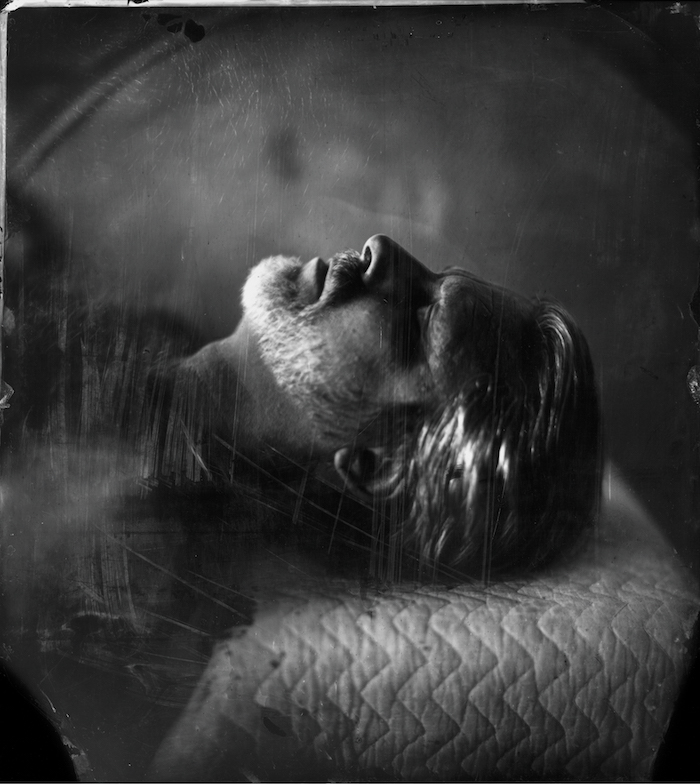
Because these men are strangers to Mann, she is unable to create the kind of intimate collaboration that animates “Immediate Family” and the photographs included here from “Proud Flesh,” a more recent series that documents the effects of disease on her husband Larry Mann’s body. Not really portraits then, these photographs seem to be more about the history of photography and other images of black bodies—from the slave daguerreotypes and lynching postcards to, as the scholar Maurice Wallace has pointed out, Robert Mapplethorpe’s pictures—than about the men themselves.
In “Abide With Me,” Mann makes black history and the history of white images of black people visible, yet she has a harder time making black lives visible. Maybe that is what the Carter family photographs are supposed to do, but their small, snapshot aesthetic cannot compete with the authority of Mann’s prints. The churches come closer, tracing a moment in the lives of these congregations when they are moving from lived reality to memory. The tintypes come closer still, with their reflective vision of swamps as sanctuaries. They suggest the power of work that grapples not just with black history but with black people as subjects, as makers of their own myths and images, and their own beauty.
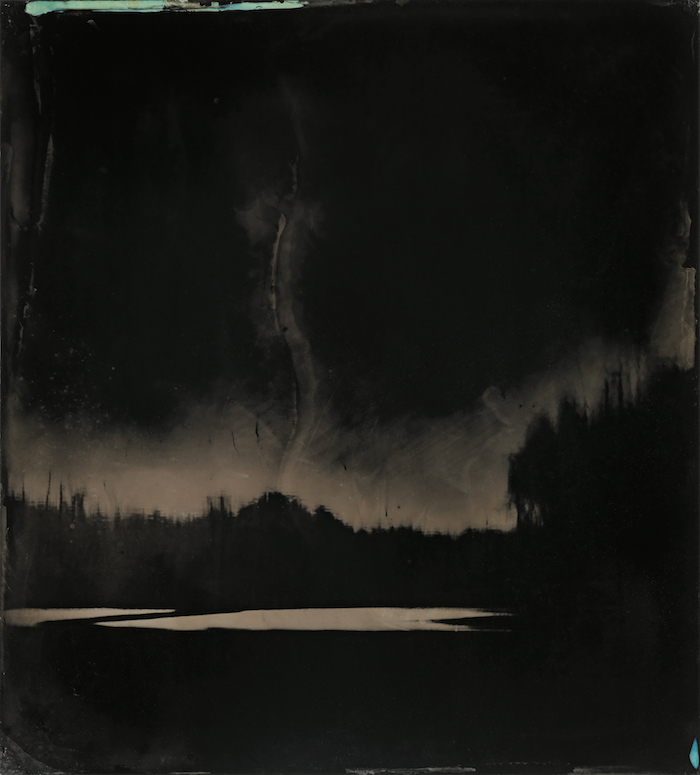
Header image: Deep South, Untitled (Stick), 1998, gelatin silver print, printed 1999, 95.7 x 119.4 cm (37 11/16 x 47 in.), courtesy of the New Orleans Museum of Art: Collection of H. Russell Albright, M.D., Image © Sally Mann.
This essay is part of our Shutter series on southern photography.
Grace Elizabeth Hale is the Commonwealth Professor of American Studies and History at the University of Virginia and the author of Making Whiteness: The Culture of Segregation in the South, 1890–1940 (Vintage, 1999), A Nation of Outsiders: How the White Middle-Class fell in Love with Rebellion in Postwar America (Oxford University Press, 2011), and Cool Town: Athens, Georgia and the Promise of Alternative Culture in Reagan’s America (forthcoming in 2017).
Born in 1951 in Lexington, Virginia, Sally Mann continues to live and work in Rockbridge County. Mann developed her first roll of film in 1969 and began to work as a professional photographer in 1972. She attended Bennington College, Vermont, and graduated in 1974 with a BA in literature from Hollins College, Roanoke, Virginia where she earned an MA in creative writing the following year. She has exhibited widely and published her photographs in the books Second Sight: The Photographs of Sally Mann (1983), Sweet Silent Thought: Platinum Prints by Sally Mann (1987), At Twelve: Portraits of Young Women (1988), Immediate Family (1992), Still Time (1994), Mother Land: Recent Landscapes of Georgia and Virginia (1997), What Remains (2003), Deep South (2005), Sally Mann: Photographs and Poetry (2005), Proud Flesh (2009), Sally Mann: The Flesh and the Spirit (2010), and Remembered Light: Cy Twombly in Lexington (2016). Mann’s best selling memoir, Hold Still: A Memoir with Photographs (2015), was a finalist for the National Book Award. She has received numerous honors as well as grants from the National Endowment for the Arts, the National Endowment for the Humanities, and the Guggenheim Foundation. In 2011 Mann delivered the prestigious William E. Massey Sr. Lectures in the History of American Civilization at Harvard University.

